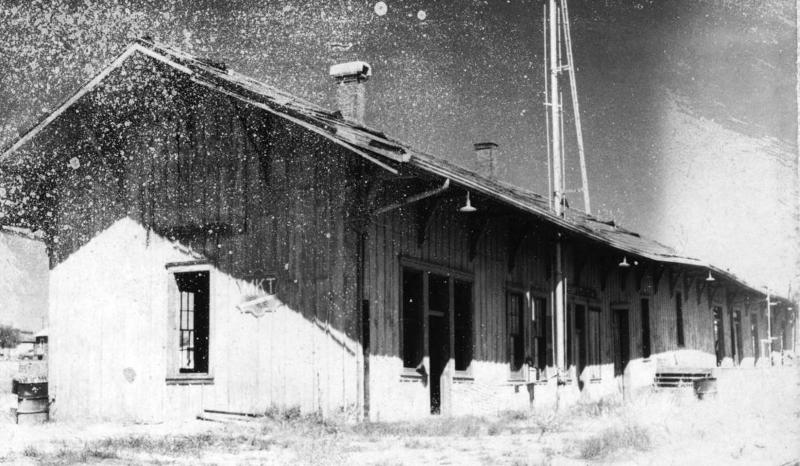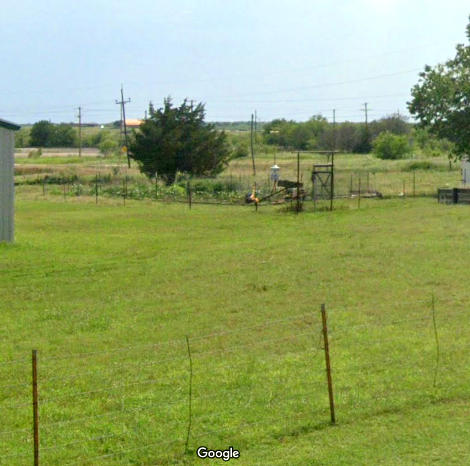
Below: There is scant evidence today of the MKT at the site of the Tower 198 crossing. The FW&D tracks remain in use, now owned by Burlington Northern Santa Fe (BNSF). (Google Earth 2021)
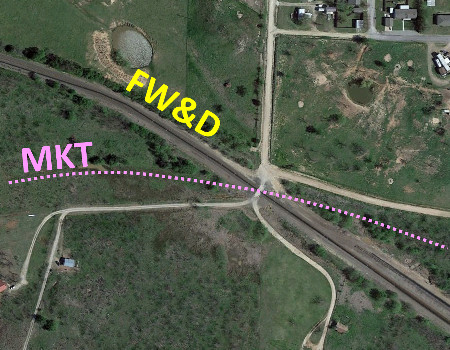
Texas Railroad History - Tower 198 - Henrietta
A Crossing of the Missouri, Kansas & Texas Railway and the Fort Worth & Denver Railway
 |
Left:
This annotated 1953 aerial image ((c) historicaerials.com) highlights
the three railroads that served Henrietta. The Fort Worth & Denver
(FW&D, yellow arrows) enters town from the southeast (right) and departs
(upper left) to the northwest to Wichita Falls. The Missouri - Kansas
-Texas (MKT, pink arrows) comes in from the east (right) and curves
northwest paralleling the FW&D. The archives
of the Railroad Commission of Texas (RCT) maintained by DeGolyer
Library, Southern Methodist University (SMU) have a document identifying
February 4, 1952 as the date the Tower 198 automatic interlocker was
installed where the two railroads crossed (red circle). Prior to that
date, all trains would have been required to stop at the crossing before
proceeding. The
abandoned grade (orange arrows) of the Southwestern Railway (SWRy)
coming in from Archer City is visible curving northeast to its former connection (blue circle)
with the MKT to enter Henrietta. The SWRy was abandoned in 1920, more than thirty
years before this aerial was taken. Below: There is scant evidence today of the MKT at the site of the Tower 198 crossing. The FW&D tracks remain in use, now owned by Burlington Northern Santa Fe (BNSF). (Google Earth 2021)  |
Henrietta was founded in 1857 as the county seat of Clay County.
It was soon abandoned due to frequent Indian raids, but in 1870,
settlers permanently reclaimed the town. The year 1882 saw the arrival of the
first railroad, the Ft. Worth
and Denver City (FW&DC) Railroad (the 'C' was dropped in 1951, becoming
simply the FW&D.) The rail line was being built from
Ft. Worth
to Wichita Falls, eighteen miles northwest of Henrietta, part of a larger
project to connect Fort Worth with Denver. Construction was
suspended for three years at Wichita Falls before resuming in 1885, reaching Harrold
34 miles farther northwest by the end of the year. FW&DC construction resumed out
of Harrold on May 24, 1886 with rapid progress through
Vernon, Chillicothe,
Quanah, Amarillo and
Dalhart. In 1888, track-laying
crews reached the New Mexico
border 37 miles northwest of Dalhart at the new town of Texline. At the border, the FW&DC connected to Colorado
& Southern rails coming south from Denver. Trains began running the entire
distance between Denver and Fort Worth in April, 1888, making stops at Henrietta.
At the time (1890 census), Henrietta had approximately 2,000 residents, a bit
larger than Wichita Falls.
In July, 1886, the Gainesville, Henrietta and Western
(GH&W)
Railway was chartered to build a 70-mile line between Henrietta and
Gainesville, where the Gulf, Colorado & Santa Fe Railroad
was building a north/south main line. More significant, however, was that Gainesville
was already the western terminus of a Missouri, Kansas & Texas (MK&T, "Katy")
branch line. [Note that the MK&T changed its name to "Missouri - Kansas - Texas"
(MKT) as it emerged from bankruptcy in 1923, but to most people, it remained simply "the
Katy".] The Katy branch to Gainesville had originally been built by the
Denison & Pacific (D&P) Railroad out of
Denison via Whitesboro in 1878-79, a distance of 42
miles. The Katy was expanding from its base at Denison where its bridge over the
Red River had spawned significant economic growth. The Katy's strategy was to
arrange for independent investor groups to establish financing and obtain Texas
railroad charters pursuant to building branch lines for the Katy. These
railroads were built with the full expectation that the completed
lines would at some point be leased, and ultimately bought, by the Katy. Despite
having little stock ownership in the Katy, rail baron Jay
Gould was elected as President of the railroad in December, 1879. A year later, Gould
leased the Katy to the Missouri Pacific (MP) Railroad where he had a large stock
ownership position. Though the public perceived MP as the face of Gould's expansion in Texas,
new lines and acquisitions were legally assigned to the Katy because MP did not have
a Texas railroad charter. Ironically,
neither did the
Katy, as was later established by a Texas Supreme Court case. The Court
ruled that Texas' 1870 state law allowing the Katy's Kansas charter to serve as
permission for track construction on the Texas side of the Red River bridge did
not grant the Katy the right to expand elsewhere in Texas (but that's
another story...)
The D&P line to
Gainesville was an example of an independent investor group
chartering a railroad that became a branch line for the Katy; it was bought by
the Katy in November, 1881. The GH&W was another such line, however, the
presence of Herbert Melville "Hub" Hoxie on the GH&W Board of Directors left no
doubt that this was a Gould operation all the way. Hoxie had a lengthy career in
railroading and was a close associate of Gould, including being named the
General Superintendent (GS) of the Texas & Pacific when Gould took
control of it in 1881. Construction of the GH&W commenced at Gainesville
in September, 1886 and the line was completed to Henrietta in April, 1887. Three
months earlier, it had been sold to the Katy during construction. Unfortunately,
Hub Hoxie did not live to see it completed. Shortly after being named President of
the GH&W, he died in New York in late 1886 at age
55 due to complications from kidney stone surgery.
Long before its
completion, there had been stories in the press about the possibility of the
GH&W continuing beyond Henrietta southwest to Abilene. This idea probably
originated in the GH&W charter, but it was reinforced by the actions of the GH&W
Board of Directors. In the same article that reported the
election of Hub Hoxie as President of the GH&W, the
Albany News of September 16, 1886 also mentioned a
dispatch from Gainesville stating that the "...stockholders of the company
have ordered the immediate construction of the road which will run ... via
Henrietta to Seymour in Baylor County." The Denison
Sunday Gazetteer of January 23, 1887 (quoting a
story from the Gainesville Hesperian on a
recent GH&W Board meeting) reported that the Board "...had resolved to issue
bonds on the finished road from this city [Gainesville] westward for
about 140 miles, at the rate of $20,000 per mile." At the time, 23 miles of
the GH&W had been completed; only 47 miles remained to reach Henrietta. As it
would take time to obtain RCT authorization for the bonds before selling them,
the bond money probably wasn't targeted for construction to Henrietta (which was
finished less than three months later.) It is worth noting that the distance
from Henrietta to Abilene via Seymour is about 140 miles. The idea of continuing
via Seymour
was not farfetched; the Wichita Valley Railway (WVRy) was chartered a few years
later and built from
Wichita Falls to Seymour in 1890. By
1908, the WVRy was part of a through route from Wichita Falls to Abilene via
Seymour.
While Gould ultimately made no move to build farther west from
Henrietta, the
history of the Katy buying branch lines encouraged investor groups to ponder building a westerly
extension. One
such group proceeded to charter the Red River and Southwestern (RR&SW) Railroad
Co. in late 1890 with a grandiose plan to build from the Oklahoma border to "Spofford
Junction in Kinney County", a location in south Texas near Del Rio only
seventeen
miles from the Rio Grande! Given the vast number of political districts through
which it ostensibly would pass, legislative approval was a foregone conclusion.
The RR&SW was able to raise initial construction funding and it managed to build
a 29-mile grade from Henrietta to Archer City.
| In A History of the Texas Railroads ((c) St. Clair Publishing Co. 1941), author S. G. Reed says little about the RR&SW (right), as it was among many roads chartered in Texas that were never built. Its 29 miles of graded ROW from Henrietta to Archer City was later used by the Southwestern Railway. |
 |
 |
Gould may have pondered building west from Henrietta at some point, but Joseph A. Kemp had a different and more urgent idea. Kemp was a Wichita Falls businessman interested in improving rail service to his town. Kemp realized that a second major railroad was needed to compete with the FW&DC, so he began courting the Katy to extend their line to Wichita Falls. Katy management had no interest in duplicating the existing FW&DC rails between the two towns, but they told Kemp they'd consider an operating agreement if someone else built the line. Kemp and other investors promptly founded the Wichita Falls Railway (WFRy) to build a line parallel to the FW&DC. The FW&DC was none too happy with the plan and they offered a last minute proposal to provide the Katy with trackage rights between Henrietta and Wichita Falls. But the offer was to no avail and the WFRy tracks were laid in 1894. The Katy took out a long term lease to operate the WFRy based on an agreement approved by RCT on November 10, 1894.
With RCT approval, the WFRy / Katy agreement took
effect and formed the basis of a contract between the two railroads for a long-term
lease. The new line quickly proved successful for the Katy and for the stockholders
of the WFRy. In his 1976 book
Katy Northwest, author Don Hofsommer explains that the "...contract resulted, in the course of a
comparatively short time, in a condition so favorable to the stockholders of the
Wichita Falls Railway that the road acquired the reputation of paying the
"largest dividends of any railroad in the United States."
Kemp partnered with
his brother-in-law,
Frank Kell, to build additional railroads to serve Wichita Falls. One of these,
the Wichita Falls & Southern (WF&S), reached Archer City in 1907 and continued
south to coal fields in the vicinity of Newcastle. That same year, the newly
chartered Southwestern Railway (SWRy) acquired the ROW of the RR&SW which
had been formally abandoned seven years earlier. The SWRy
laid nineteen
miles of track on this ROW from Henrietta to Scotland in 1908. Two years later,
the remaining ten miles was completed to Archer City where a connection
was made to the WF&S. The SWRy was never profitable, and between 1913 and 1918,
its liabilities grew 700% to more than $600,000, leading to its abandonment in 1920-21.
Approximately nine miles of the SWRy grade sits beneath the surface of Lake
Arrowhead, a municipal water supply reservoir for Wichita Falls built in the mid 1960s.
The WF&S fared much better. It was extended farther south to a junction known as Jimkurn where it connected to the Wichita Falls, Ranger & Fort Worth (WFR&FW)
Railroad. This created a route from Wichita Falls through Breckenridge and
Ranger to Dublin. In 1911, the Katy purchased
three Kemp and Kell railroads: the WF&S, the WFRy and another railroad, the
Wichita Falls & Northwestern (WF&NW) Railway. In 1920, Kemp and Kell repurchased all of the WF&S
stock from the Receiver managing the Katy's bankruptcy, returning the WF&S to
independent operation for another three decades (most of it was abandoned in
1954.) Additional lines and branch acquisitions by the Katy in western Oklahoma
combined to create a sizable northwest network largely driven by the shipment of
agricultural products. The WF&NW provided the link back to Wichita Falls as the
gateway to the remainder of Katy's system.
Trains still pass through Henrietta daily; the former FW&D
has remained an
active main line since its inception. It was absorbed into Burlington Northern long ago and
the tracks are now
owned by successor Burlington Northern Santa Fe (BNSF). Under Katy ownership,
the tracks between Henrietta and Wichita Falls remained operational until 1970.
That year, on January 2nd, the Katy's entire Henrietta Subdivision -- from
Whitesboro through Henrietta to Wichita Falls -- was abandoned. The Katy had
already applied to abandon its northwest network in western Oklahoma, but permission had not yet been granted. Hence, the Katy obtained
trackage rights on the FW&D between Ft. Worth and Wichita Falls for the purpose
of retaining access to the Oklahoma lines. Those lines were mostly abandoned
later in the 1970s, although track segments remain intact today, operated by
other railroads. The Katy was acquired by MP in 1988, becoming part of Union
Pacific (UP) which had purchased MP six years earlier. Today, all of UP's
railroads are consolidated into a single UP operating entity. As there were
no longer any Katy tracks through Henrietta after 1970, UP does not have tracks
in the vicinity, but it does have trackage rights on BNSF's route from Ft. Worth
through Wichita Falls to Amarillo and beyond.


Above Left: This 1954 aerial image ((c)historicaerials.com)
shows a somewhat triangularly-shaped yard bounded by the railroads on two sides, with interchange and storage tracks
located adjacent to the
Tower 198 crossing. The FW&D depot was in the lower right corner of the
triangle. Above Right:
Vegetation has reclaimed most of the triangular yard, abandoned long ago.
Below Left: the FW&D depot c.1950,
photographer unidentified, from the Wichita Falls Railroad Museum (hat tip,
Chino Chapa.) Below Right: This undated photo by Everett DeGolyer,
Jr. (SMU library collection, hat tip, Jay Vollet) shows a train passing the FW&D depot in Henrietta. Jay comments: "Outside
braced cabooses were built from former CB&Q [Chicago, Burlington & Quincy] box
cars. Of note are the two former WWII Army kitchen cars turned into FW&D mail
cars in front of the caboose."
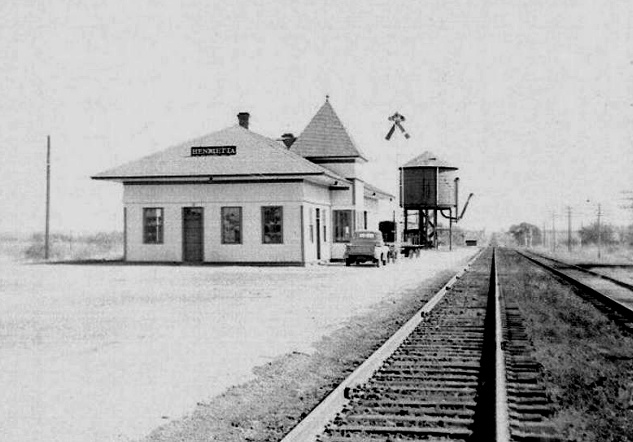
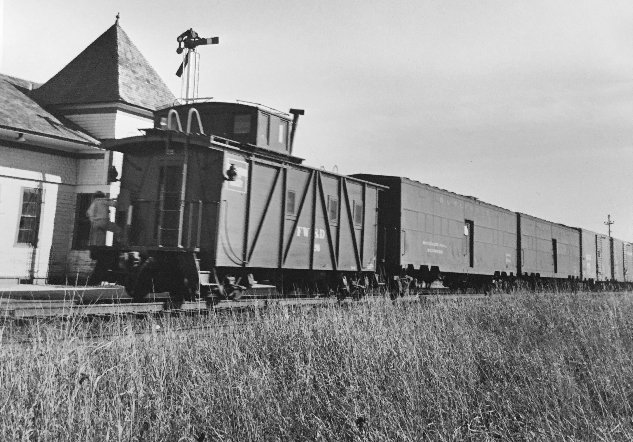

Above: In 2007, the Google
Street View vehicle visited the site of Tower 198. Looking southeast directly
down the former Katy ROW, the BNSF tracks to the right proceed past the former
FW&D depot site in the distance. The end of a spur track is also visible; this
spur can be seen in the 2021 aerial image further above. The relative proximity
of the interlocker to the FW&D depot (0.3 miles apart) allowed select northbound
passenger trains to pull up to the interlocker and stop there to discharge and
accept passengers, thereby eliminating a second stop that would otherwise be
necessary if the train had stopped close to the station. An FW&DC Employee
Timetable dated June 2, 1940 states "Passengers leaving or boarding No. 2
at Henrietta will do so at point where train makes stop for M-K-T Crossing and
not at depot." It is not readily apparent why No. 2 was singled out. The
rule apparently did not apply to train No. 8, a daily northbound passenger train
that arrived at Henrietta at 1:07 am (No. 2 arrived at 4:56 pm.) Southbound
passenger trains were unaffected since they stopped for the crossing before
reaching the station.
Below: From the same location
in the opposite direction, the Tower 198 crossing diamond
would have been visible in the immediate foreground. The Katy ROW ran northwest along the left edge
of the nearby clump of trees as it gradually curved away from the FW&D tracks
before turning back to the right to become parallel all the way to Wichita
Falls.
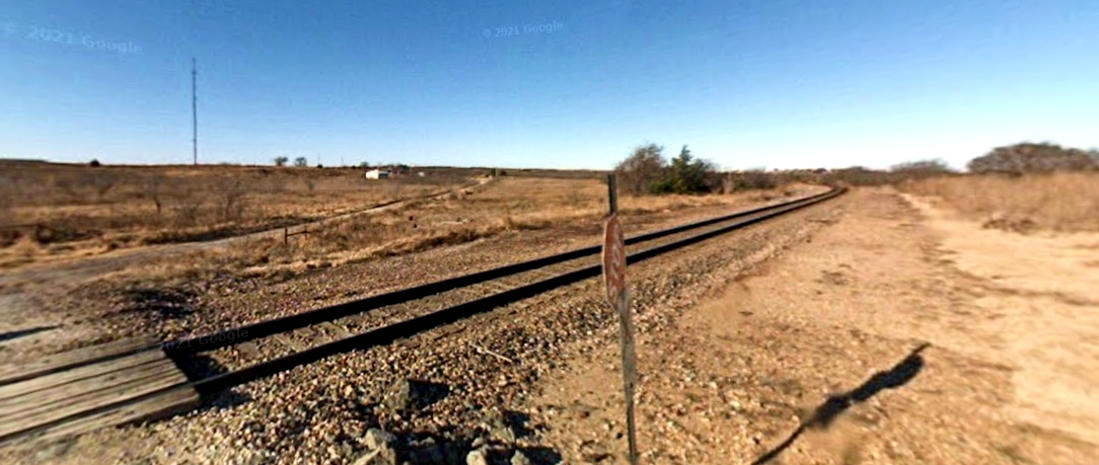

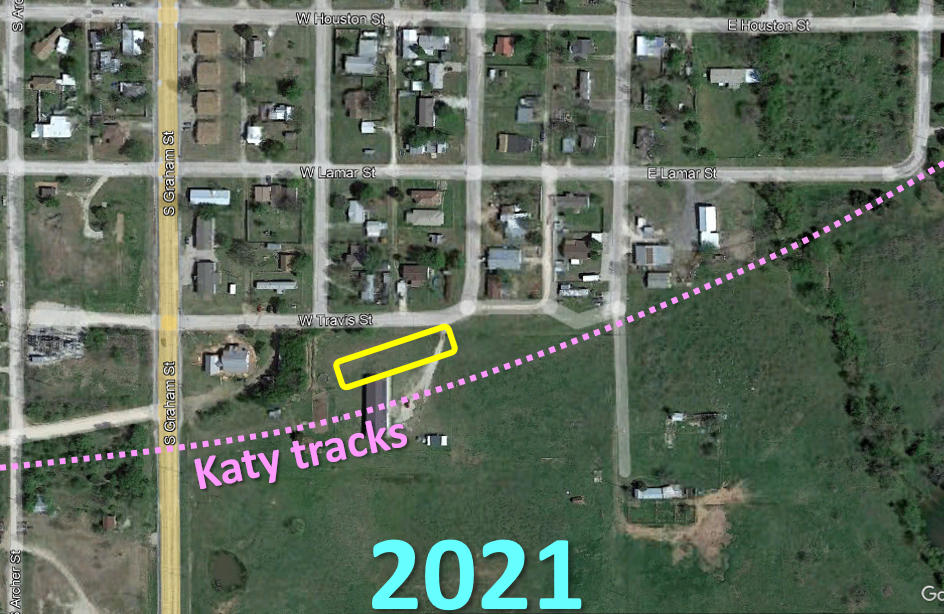 Above Left: This 1954 aerial image ((c)historicaerials.com)
shows the Katy depot (yellow rectangle) adjacent to the tracks on the south side of Travis St.
near its
intersection with Main St. This depot appears on the 1934 Sanborn Fire Insurance
map of Henrietta identified as "Passenger & Freight Sta." It was approximately
0.2 miles northeast of the
FW&D depot. The small dark rectangle along the tracks east of the depot,
just beyond Bridge St., is not a building. It is probably a locomotive or
perhaps a few railcars
casting a shadow since it does not appear on either of the 1953 or 1955 aerials. Above Right:
Today, the Katy depot is long gone with no sign of its former presence. Its fate
has not been determined. Below Left: the Katy depot c.1930 (University of North Texas
Libraries) Below Right:
There's no longer any indication that the Katy depot ever sat in this field
between the foreground fence and the building barely visible at left. (Google Street View, June 2023)
Above Left: This 1954 aerial image ((c)historicaerials.com)
shows the Katy depot (yellow rectangle) adjacent to the tracks on the south side of Travis St.
near its
intersection with Main St. This depot appears on the 1934 Sanborn Fire Insurance
map of Henrietta identified as "Passenger & Freight Sta." It was approximately
0.2 miles northeast of the
FW&D depot. The small dark rectangle along the tracks east of the depot,
just beyond Bridge St., is not a building. It is probably a locomotive or
perhaps a few railcars
casting a shadow since it does not appear on either of the 1953 or 1955 aerials. Above Right:
Today, the Katy depot is long gone with no sign of its former presence. Its fate
has not been determined. Below Left: the Katy depot c.1930 (University of North Texas
Libraries) Below Right:
There's no longer any indication that the Katy depot ever sat in this field
between the foreground fence and the building barely visible at left. (Google Street View, June 2023)
